After being knocked out by Leicester City in the English Football League Cup in the midweek fixture, Everton had to carry on. In this round of the Premier League fixtures, they played against Arsenal at Goodison Park.
The game kicked off with an intriguing circumstance as both teams had identified their managers, so it was the last game for both caretaker managers, Duncan Ferguson and Freddie Ljungberg. However, this was not a meaningless game for the players, as they had to show their ability to the new bosses, while their teams needed the points.
In this tactical analysis, we are going to show you the tactics of Everton and Arsenal through an analysis.
Lineups
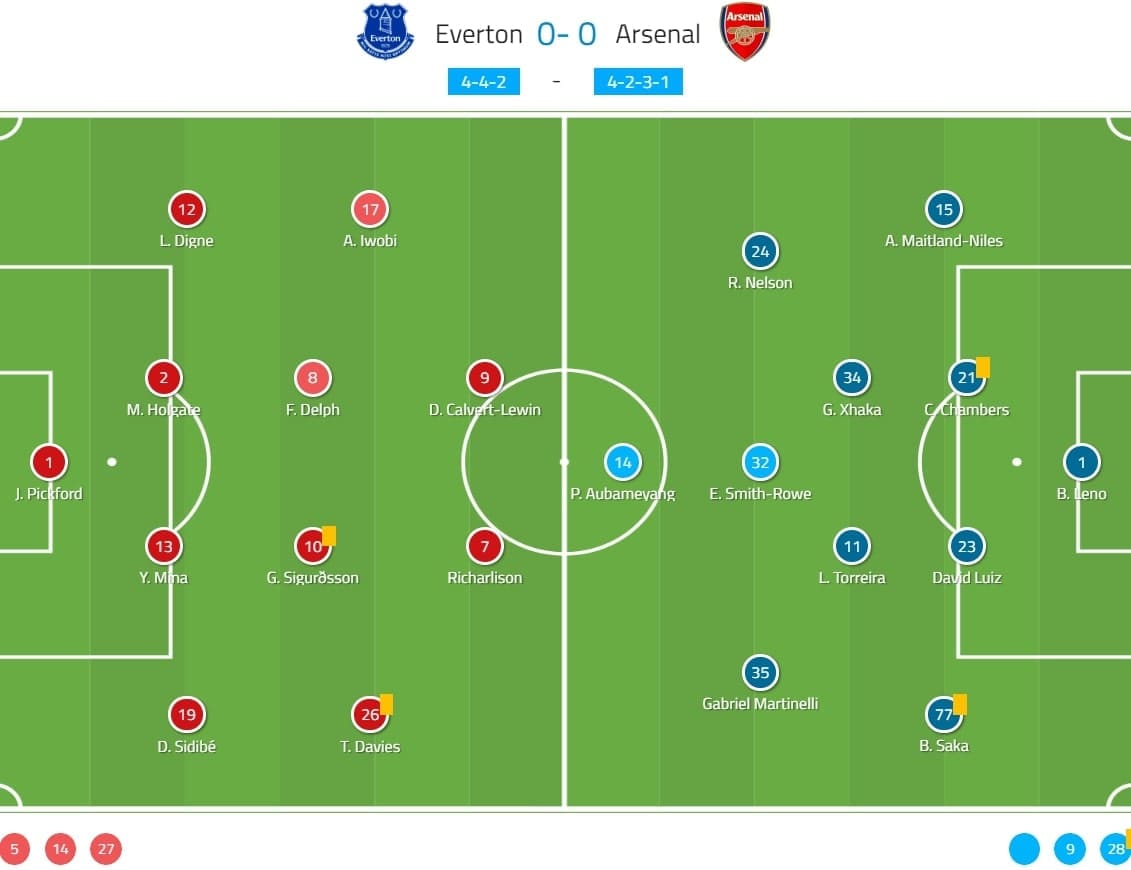
Everton played in a 4-4-2 formation. Seamus Coleman, Bernard, and Michael Keane were left on the bench. Mason Holgate and Yerry Mina partnered at the centre of defence; Djibril Sidibé played as a right-back. Tom Davies, surprisingly, played on the right of the midfield. Fabian Delph recovered from a muscle injury and returned to the team.
Arsenal did not have Mesut Özil in this game since the German international was suffering from a foot injury. Youngsters Emile Smith Rowe, Bukayo Saka, Reiss Nelson, and Gabriel Martinelli also started the game. Big names such as Alexandre Lacazette and Nicolas Pépé were meanwhile on the bench. Granit Xhaka had also returned to the squad. They played in a 4-2-3-1 formation.
The build-up plan of Arsenal
Arsenal were a team that preferred to play out from the back, and Ljungberg instructed his team to do so. They intended to start the attacks with numerical superiority in the first phase of the attack. Usually, Everton were positioned only with two strikers, Richarlison and Dominic Calvert-Lewin at the centre of the pitch when defending.
As shown below, Arsenal’s build-up plays involved Calum Chambers, David Luiz, Xhaka and Lucas Torreira. Therefore, it was a four v two situation in this phase, with two layers in the build-up, like a ‘box-shape’. In the first half, the pivots seldom dropped and their build-up was disrupted by Everton’s defence, which we are going to explain in the next section.
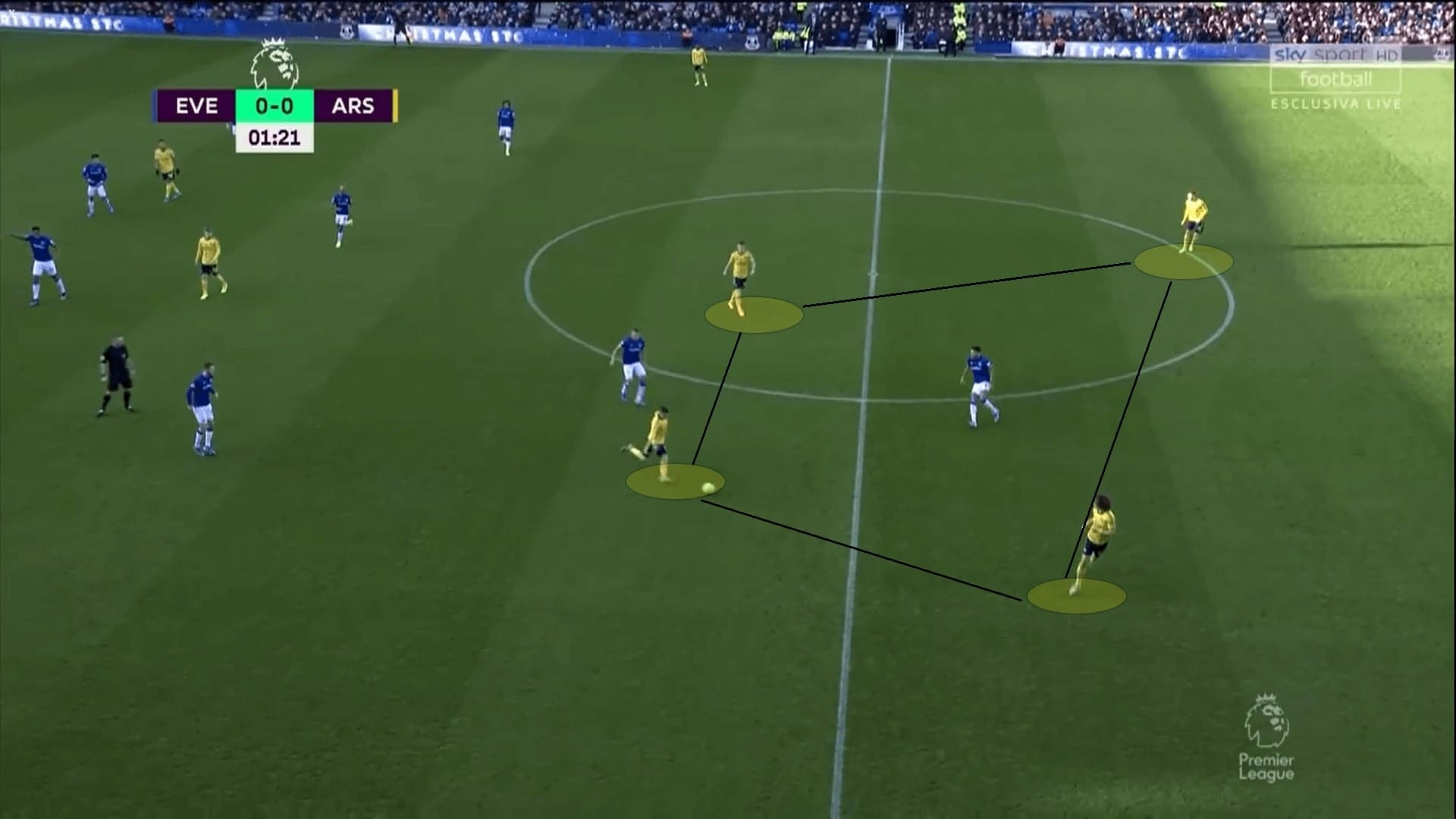
Everton’s defence
Despite Arsenal having a stable structure in the first phase of the attack, they could hardly create any chances. They only registered one shot in the first half which shows the difficulties they faced to create chances, and this was because of Everton’s defence which denied Arsenal’s build-up.
The Toffees defended in a 4-4-2 shape in this game, with the strikers forming the first defensive lines and were tasked to shut the passing lanes to Xhaka and Torreira. As a result, the centre-backs played the ball to the sides, finding the full-backs. However, these passes triggered the press of Everton players.
Once the ball was on the full-backs’ feet, Everton quickly locked the ball side, forcing Arsenal to play long. As illustrated in this image, Saka received the ball from Luiz, and in that instant, all his closest options were marked by Everton players. Everton payers on the far side came into the centre, allowing the rest to lock the ball side. So both Arsenal pivots and Luiz were marked.
Saka tried to play a quick one-two with Torreira, however, they were not good enough to break the press as their passes were inaccurate under pressure. Torreira’s return pass was intercepted by the Everton players.
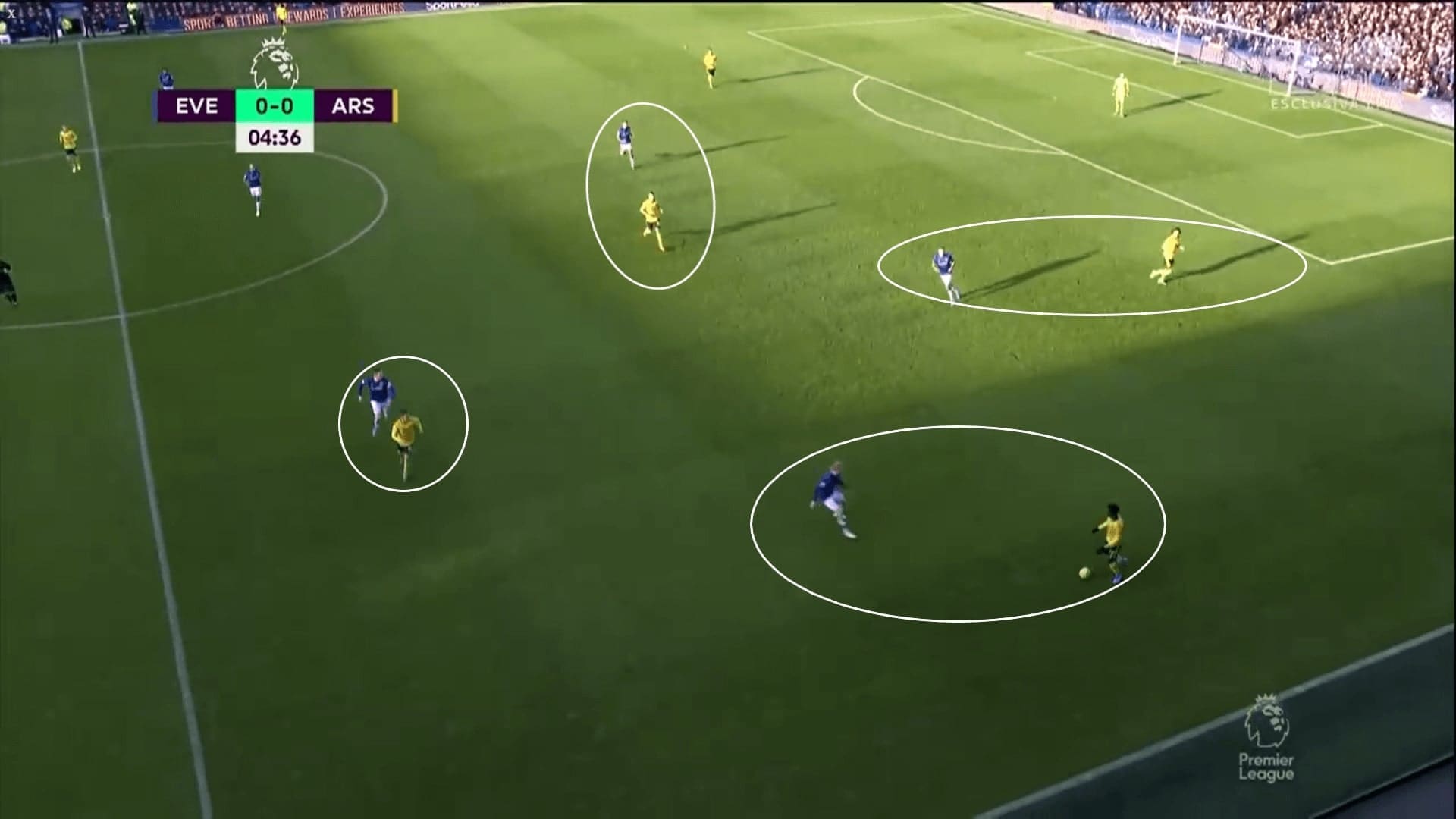
Everton’s block was far from perfect as it wasn’t compact since their defenders seldom cooperate with the press. In the first half, Arsenal failed to exploit those spaces.
Arsenal lacked creativity
Arsenal only managed to secure a shot in the 44th minute, and their xG in the first was 0.23 only. It hinted at their lacked creativity in the final third. In order to demonstrate the problem, we use the following situation to explain the details.
As mentioned, Everton’s defence was not compact, as, in this situation, horizontal distances between the players were large. On the left flank, it was a four v four situation. On the opposite side, the situation was the same as well. It was a very good chance for Arsenal to create chances in the attacking third, but they failed to do so.
Despite Martinelli, Saka, and Smith Rowe forming a passing triangle, Xhaka did not play the ball to that area. Actually, there were many combinations to progress the attack on this side, for example, finding Saka with a third-man play through Smith Rowe; or, given the distance between Holgate and Mina, Martinelli could make a forward run to attack the goal.
As Xhaka moved the ball to Torreira, they seemed to exploit the larger space on the right flank but the movements of Arsenal players were poor. Despite Pierre-Emrick Aubameyang and Nelson pinning Holgate and Lucas Digne, they did not capitalise on this two v two situation – they merely waited for the Uruguayan to play long for Ainsley Maitland-Niles. Aubameyang and Nelson neglected the huge spaces for short passes, where they could have offered passing options for Torreira. For example, a simple reversed movement will help.
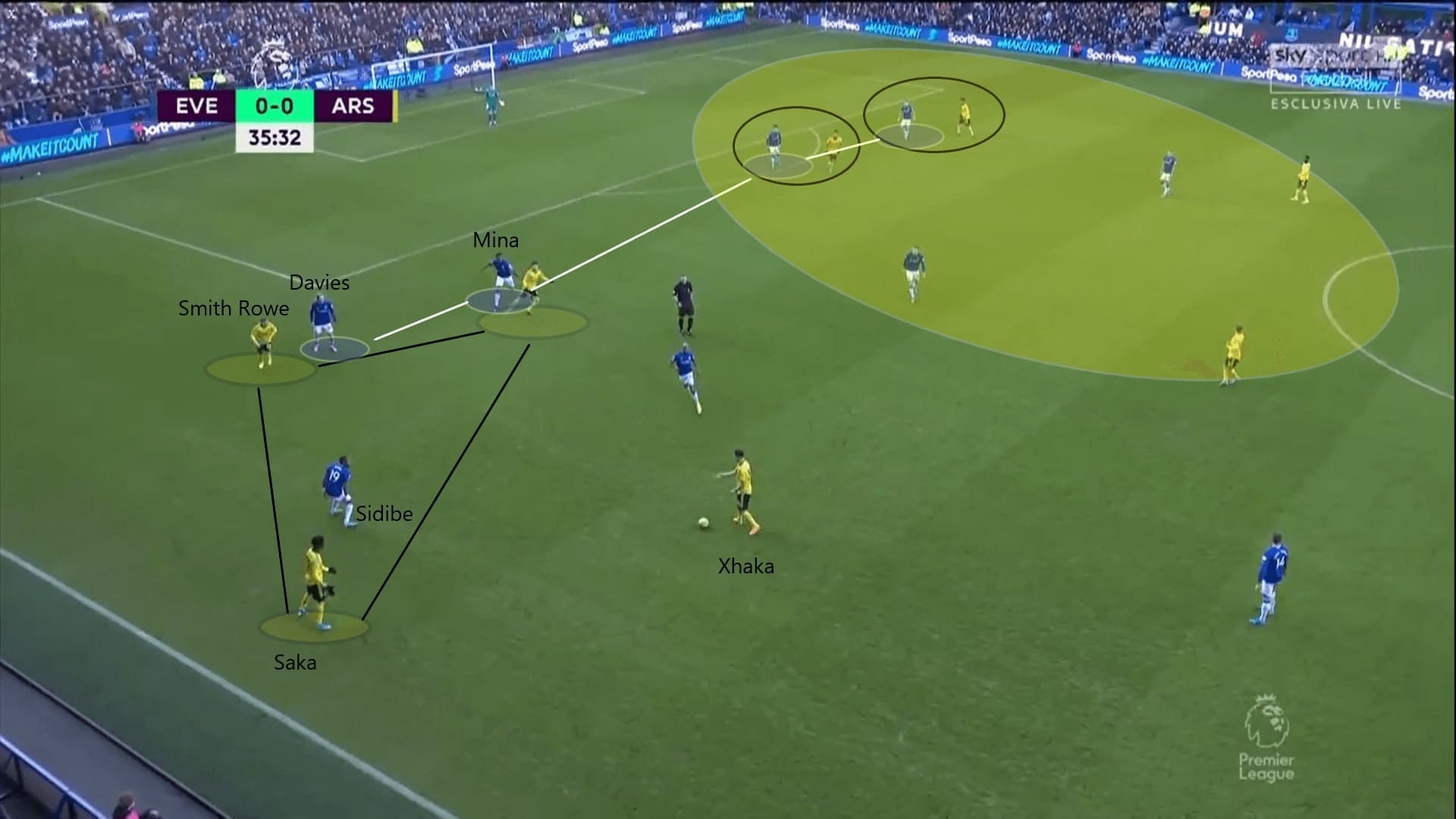
Apart from positional plays, Arsenal performed poorly in offensive transitions as well. In this match, they had 12 occasions to counter Everton, but disappointingly, none of these occasions was converted into shooting chances. It was because of their poor decision-making that they lacked quality crosses. They made unnecessary dribbles and only one of the 11 crosses were accurate.
Poor press from Arsenal
Apart from the inefficient attack, Arsenal also had serious issues in their defence, especially when they pressed high. Their high press lacked intensity, organisation, and objectives. It seemed it was just the self-reaction of players to press.
This example was one of the poorest defensive displays of Arsenal. Usually, no matter how the team is going to press, they have to work hard to create some ideal situations for themselves – making the area of plays smaller, limiting the passing options, for example.
On this occasion, Everton played out from the back comfortably. On the right side of Everton, numerical equality was reached as three Arsenal players came to that side. However, as connected by the white lines, Sidibé, Mina, and Sigurðsson formed a passing triangle in a rather opened shape so they got spaces to move the ball.
It was easy for Everton to break the press as Sidibé just dribbled inwards into the space between the Arsenal players. Worse still, Nelson was not defending. Arsenal left two Everton players free on the far side, Delph and Holgate – Nelson was nowhere near them.
After the French right-back found Delph, Nelson was confused by the situation: if he pressed Delph, then Digne was unmarked. So he backed off, and Delph then progressed the ball easily.
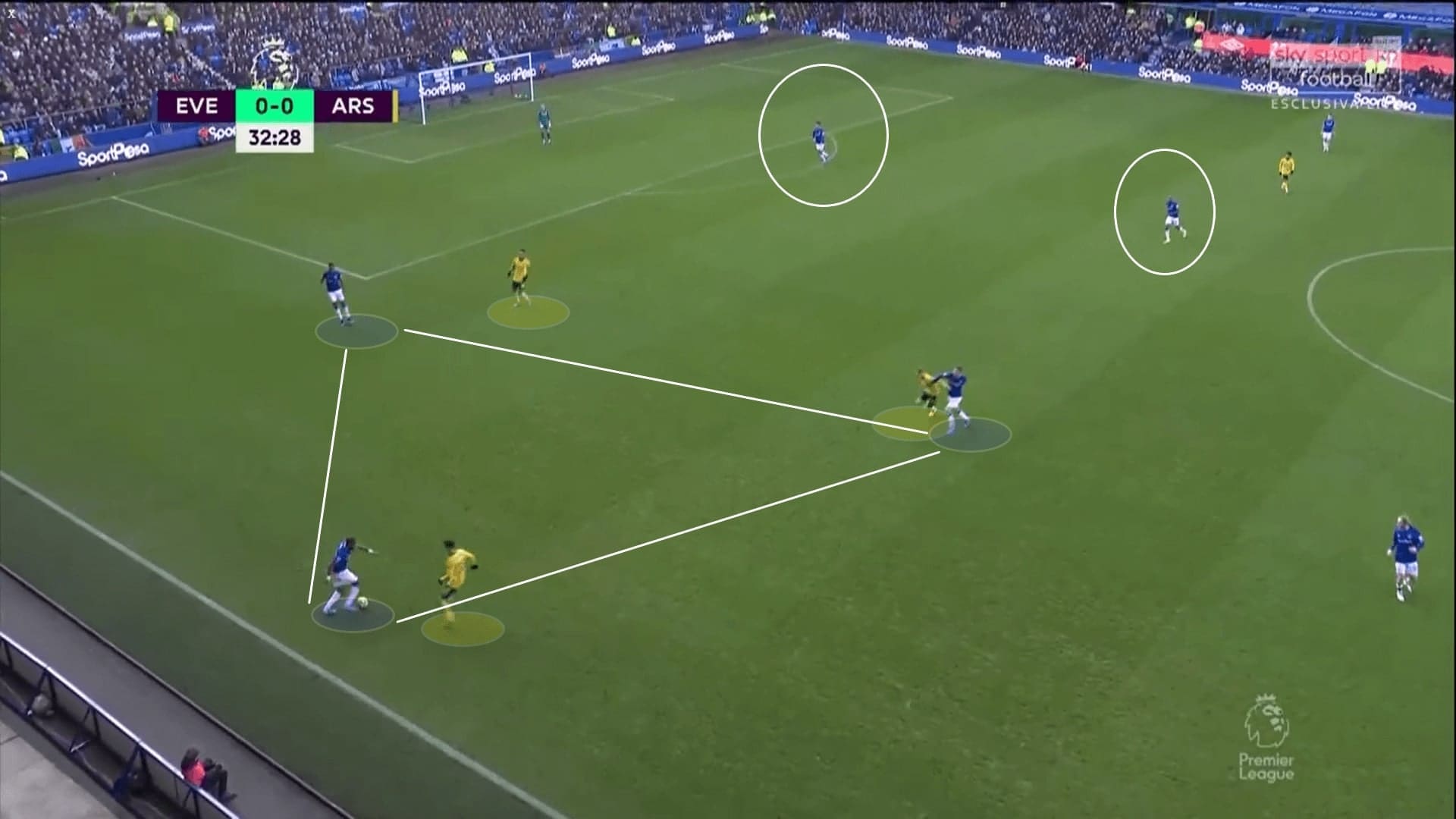
The attack of Everton
Apart from the poor press of Arsenal that allowed Everton to play out from the back, the Toffees also created their chances through direct approaches. They capitalised on the spaces behind Arsenal full-backs as Saka and Maitland-Niles usually stepped out early to press the ball. Therefore, one simple pass could hit the space behind them.
Everton players were aware of exploiting those spaces as, on this occasion, Richarlison already exploited those spaces behind. When Everton could not play out from the back, Sidibé simply placed the ball into that area, and Everton easily accessed to the attacking-third.
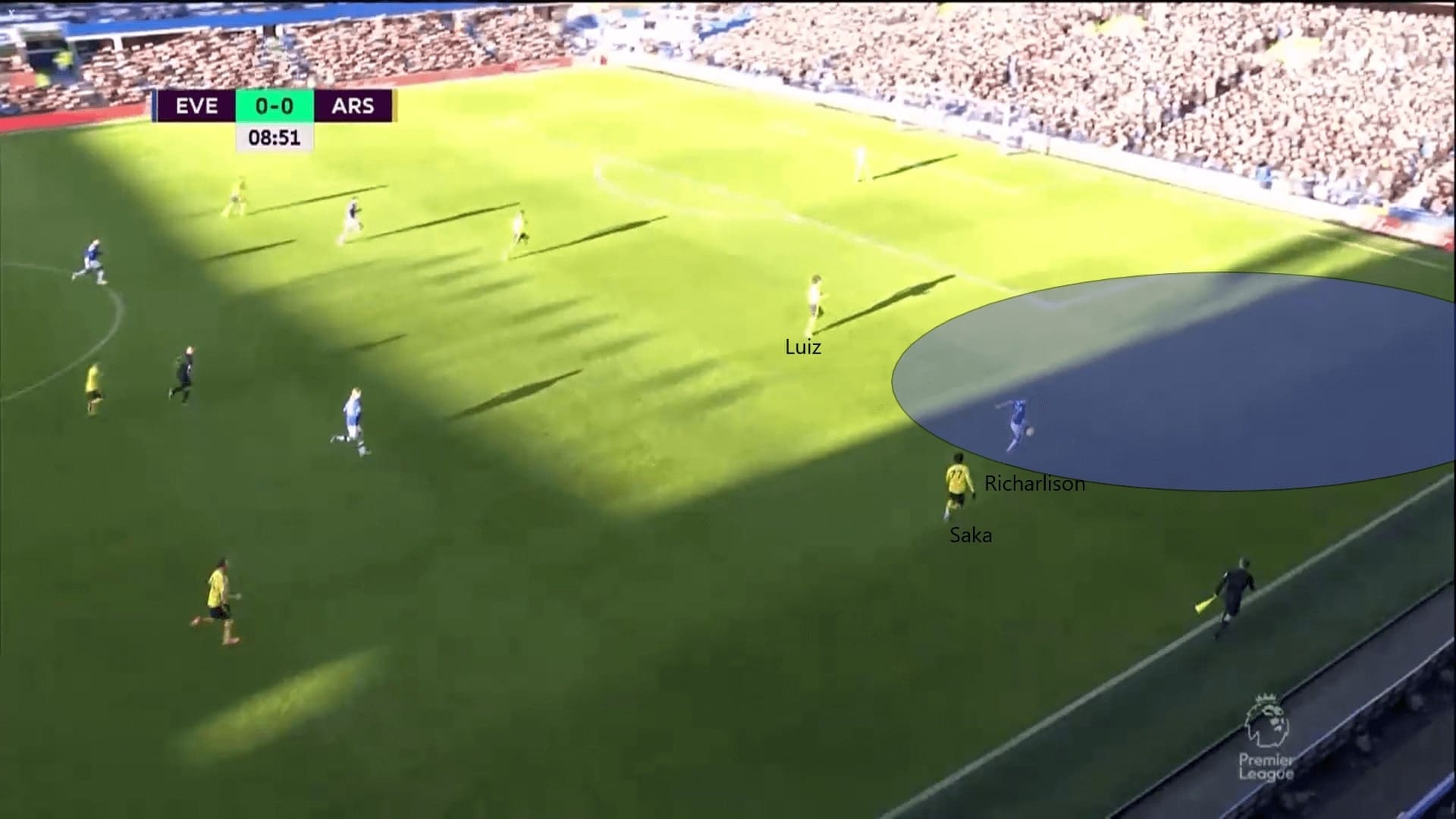
Another outlet of Everton’s attack was the presence of Calvert-Lewin. The 22-year-old English forward was very strong in the air, as reflected in statistics. He won 14 of his 17 aerial duels (82%). According to the below graph, the functions of Calvert-Lewin were twofold. On the left area in Everton’s half, Calvert-Lewin won the balls to help his team to progress the attack. Meanwhile, in Arsenal’s half, his presence helped Everton attack the final third as his layoffs were picked up by his teammates.
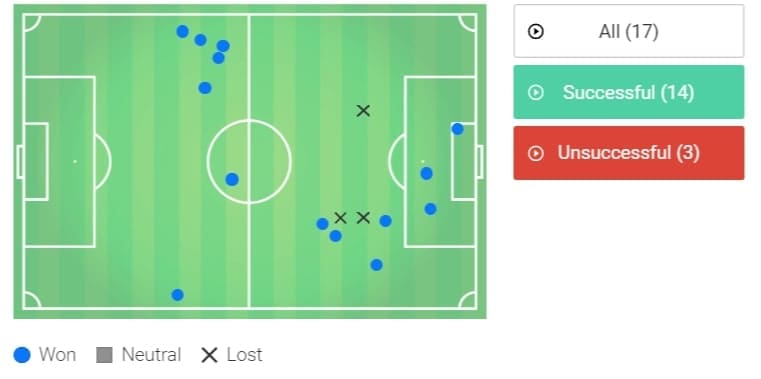
Throw-in was equivalent to a set-piece for Everton
Contrary to Marco Silva’s tactics, Ferguson utilised throw-ins to create chances. Everton planned to attack with throw-ins as teams do with set-pieces. Usually, when Everton had throw-ins on the left of the attacking-third, Digne would be the thrower.
In these attacks, Mina also joined. Ferguson instructed two of his strongest players, Calvert-Lewin and Mina, to stay at the front post. These two players drew the attention of most Arsenal players, as circled, so Mina could take three Arsenal players with him. As a result, Richarlison and Cenk Tosun were left in a one v one situation separately.
If Mina and Calvert-Lewin could head the ball to the back post, Everton would get huge chances to score. In this match, however, Arsenal managed to prevent this situation.
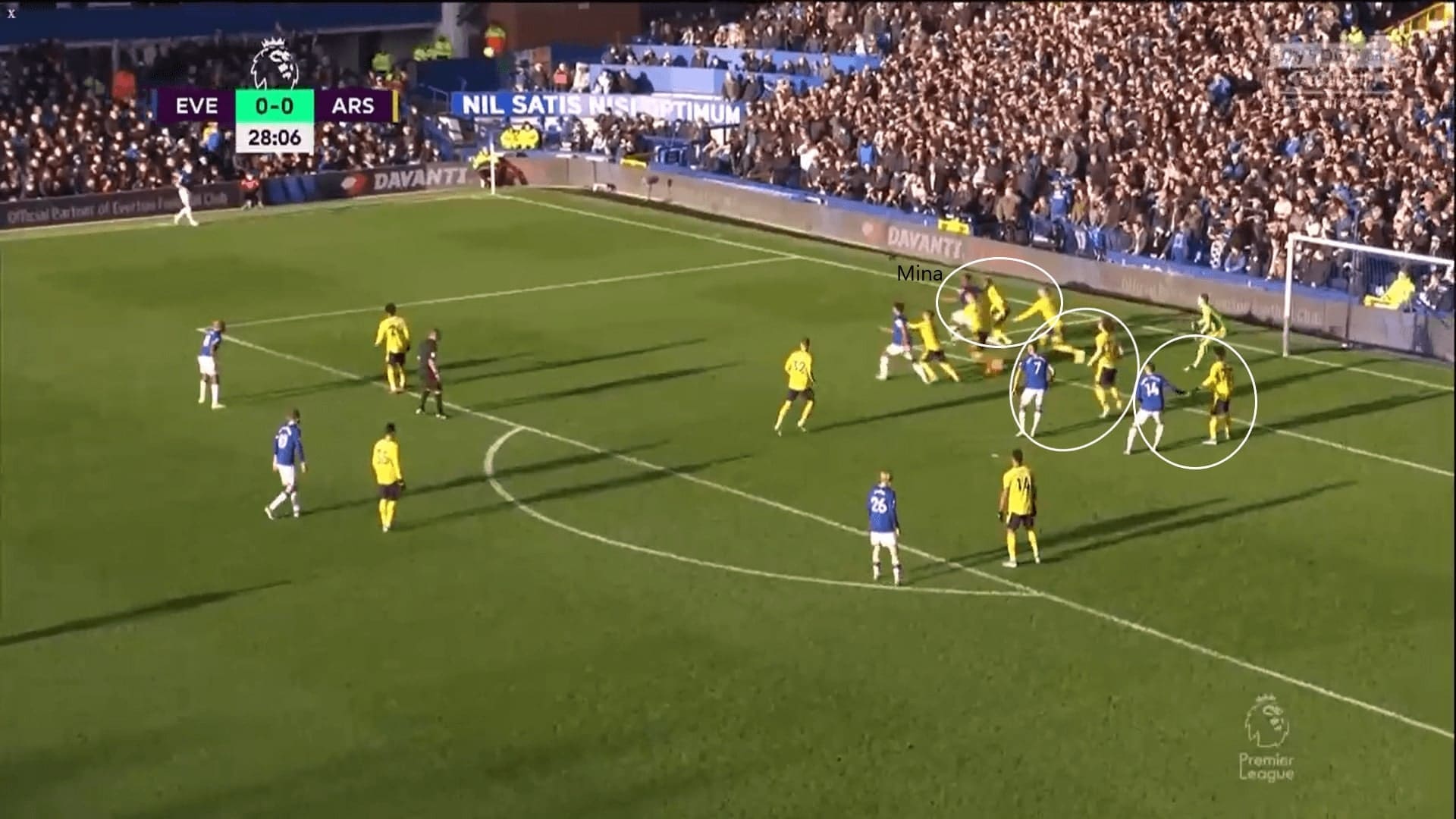
Improvements of Arsenal in the second half
After the break, Arsenal were more aggressive in the attack. They found solutions to play out from the back. The xG of Arsenal in the second half was higher, 0.61. However, their quality in the final third was still missing.
One possible solution was to add an extra man, Xhaka, between the centre-backs. As reflected in the image, Xhaka dropped and Tosun stepped out to close off the Swiss. The defensive shape of Everton became 4-4-1-1, hence, space behind Tosun was generated. After receiving the ball, Torreira could dribble into space comfortably to progress the attack.
Under this circumstance, the defensive shape of Everton was not compact. Richarlison and Davies were further stretched by the Arsenal full-backs, who positioned themselves wide. With this structure, Arsenal could penetrate centrally instead of going wide early and Torreira then found Smith Rowe, who positioned himself between the lines.
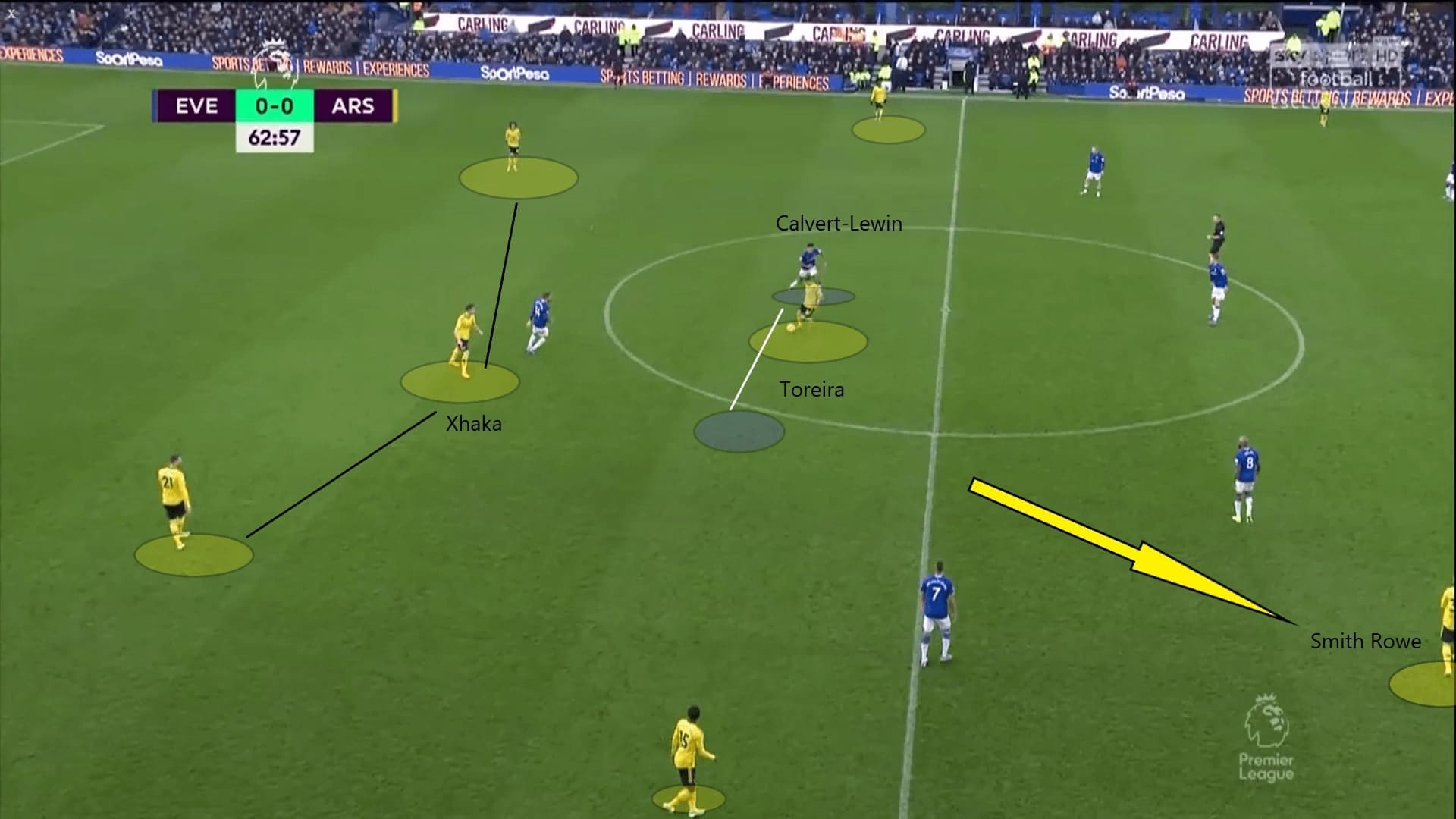
In the first half, the pivots of Arsenal merely stood in front of the centre-backs instead of moving around to provide themselves as options. After the break, Torreira showed incentive to go forward and Luiz, who was the better centre-back on the ball, tried to carry the ball forward. These movements created spaces for Arsenal.
In this situation where Luiz tried to start an attack, he was followed by Calvert-Lewin. Torreira’s forward movement gave room for the Brazilian to dribble as he took away Sigurðsson. Furthermore, the Uruguayan also exploited the spaces between the lines. Luiz passed vertically to find Torreira, so Arsenal could progress their attack.
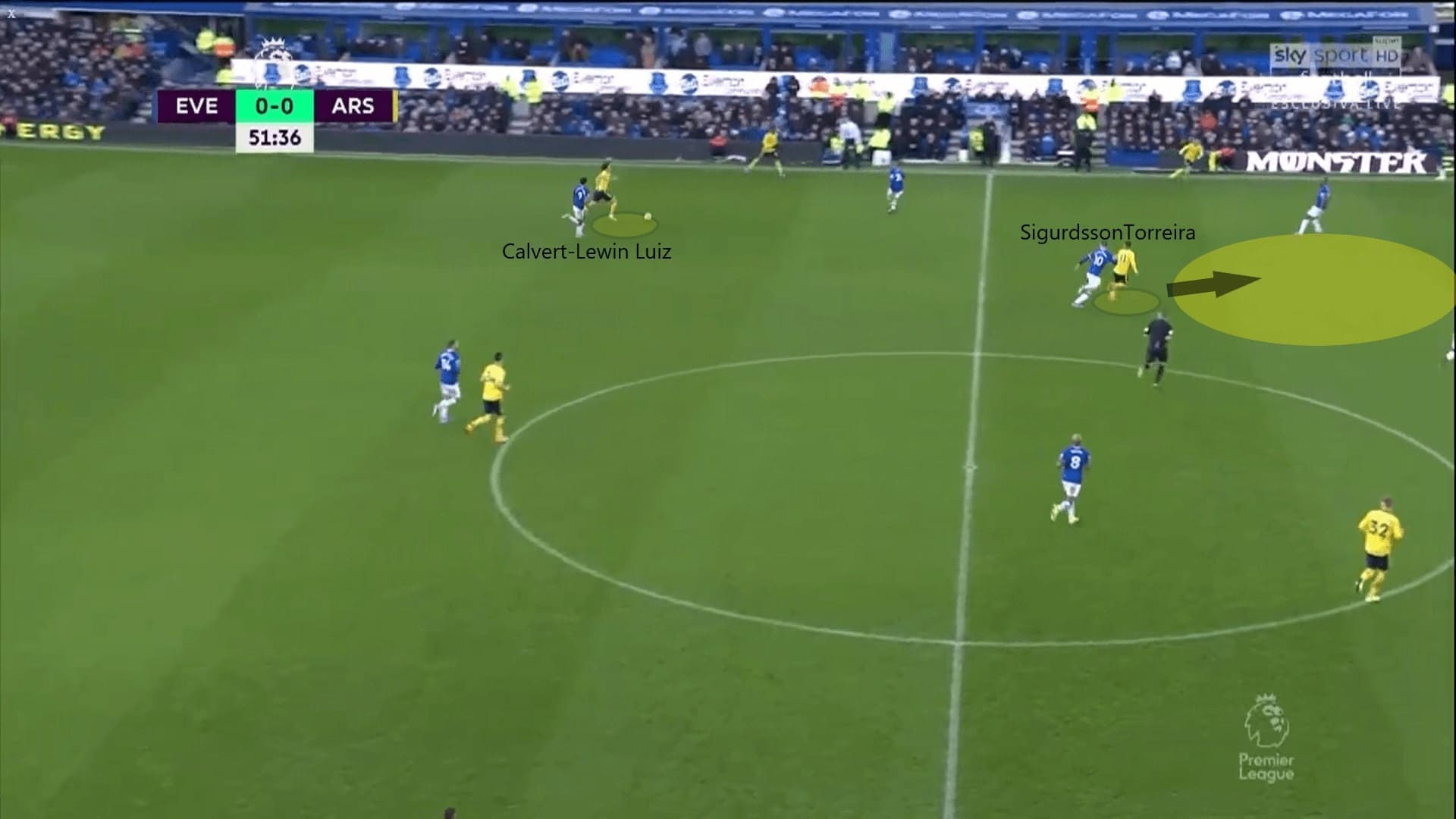
When Arsenal progressed forward, they also capitalised on the horizontal gaps between defenders. The right-back of Everton, Sidibé, usually stepped out early. However, Mina did not adjust his positions to reduce their distance.
In this example, we show how Arsenal exploited spaces behind defenders through horizontal gaps. Davies did not give enough pressure to Saka, meanwhile, Martinelli positioned himself wide and took Sidibé out of position, so Saka then passed through Mina and Sidibé and found Martinelli in the highlighted area.
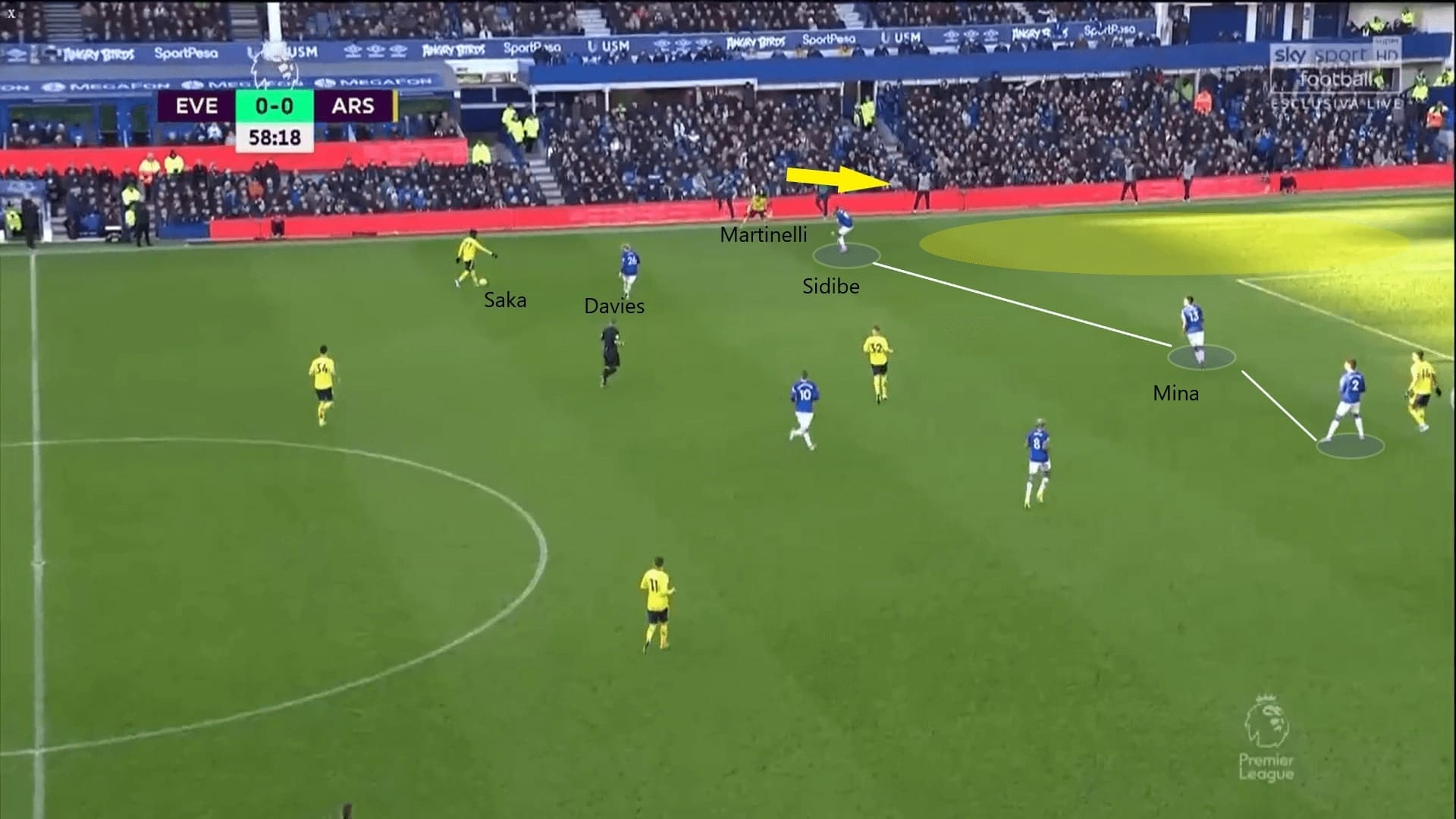
Conclusion
This might be seen as a boring match since both teams missed the quality in the final third. Everton played simple direct football for games under Ferguson, and we don’t know how Carlo Ancelotti would change the team, but at least they kept themselves four points clear from the relegation zone now.
Arsenal have problems in both ends, so there were many issues for Mikel Arteta to pick up. In this match, despite starting many youngsters, their performance was not good enough to secure a win. In view of how Everton prevented the build-up of Arsenal, it seemed the Gunners may lack composure or technique to play out from the back and so they dropped to 11th after this draw.

If you love tactical analysis, then you’ll love the digital magazines from totalfootballanalysis.com – a guaranteed 100+ pages of pure tactical analysis covering topics from the Premier League, Serie A, La Liga, Bundesliga and many, many more. Buy your copy of the December issue for just ₤4.99 here





Comments